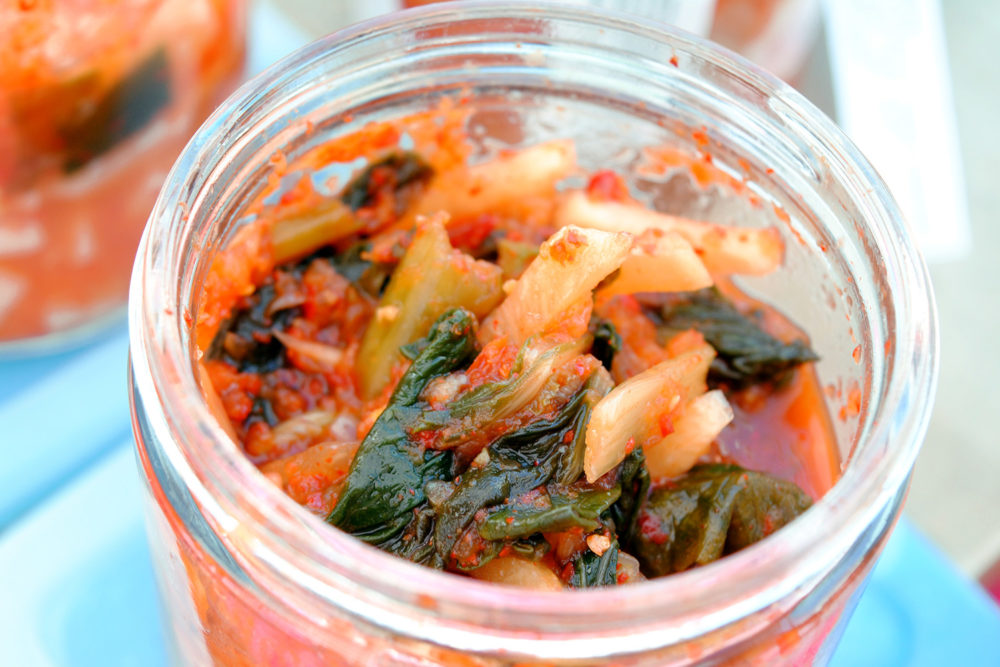
Napa Cabbage Kimchi
Source: Aruna Lee, Volcano Kimchi

Recipe Type: Appetizers and Sides | Seasons: Autumn, Spring, Summer, Winter
A lot of people are surprised to learn that you can make delicious, vegan kimchi without fish sauce or shrimp paste. I use shiitake mushroom powder and seaweed in place of seafood to get that umami flavor. As an added benefit, both of these ingredients also add extra protein and iron to the kimchi.
When making kimchi, you’ll want to plan your day accordingly (kind of like when you bake bread). You’ll do your chopping and brining in the morning. While the chopped cabbage is brining, you’ll prepare the kimchi sauce using the recipe below. By lunch you’ll be ready to rinse and drain the cabbage.
The beauty of this recipe is that once you have it down you can swap out the base ingredient (in this case Napa cabbage) with pretty much any vegetable you want. I also make jicama, beet, and bok choy kimchi, all of which work terrifically using this same recipe. I’ve done rhubarb with nectarine, watermelon rinds, and various other kinds of cabbage. Each one comes out delicious and distinct.
Makes about 2 quarts
INGREDIENTS
2 heads napa cabbage (about 6 pounds)
½ cup coarse sea salt
2 tablespoons rice flour
½ cup filtered water
1 medium yellow onion
1 tablespoon ginger
2 tablespoons garlic
½ medium Asian pear
6 fresh red chiles (optional)
1 tablespoon shiitake mushroom powder
½ cup Korean (gochugaru) red pepper flakes (or a mix of American and Korean chile flakes)
1 or 2 pieces of kelp
1 daikon radish (about ½ pound) shredded
4 scallions, cut into ¼ inch pieces
1 bunch red mustard greens, chopped
½ tablespoon pink Himalayan salt
PREPARATION
To prepare the cabbage for brining: Hold the stem side of the cabbage firmly in your hand with the leafy side pointing down. Using a large kitchen knife, cut lengthwise through the head of cabbage about half way, then use your hand to tear the two halves of cabbage apart. (Tearing the cabbage instead of slicing all the way through keeps the smaller leaves whole.) Using the same method as above, cut and tear the two halves into quarters. Remove the core from the cabbage quarters. Cut the quarters crosswise into approximately 1-inch slices.
To brine the cabbage: Add the sea salt to the chopped cabbage and toss with your hands in a bowl just large enough to contain the cabbage. After tossing, place a heavy weight over the cabbage. The weight will compress the cabbage, ensuring that even the upper levels are submerged in the brine. Let stand for 2-3 hours, depending on temperatures (warmer temperature mean less time brining).
To make the kimchi sauce: Mix the rice flour with the filtered water, boil, and stir until mix begins to thicken. Let cool. While the rice flour is cooling, prepare the daikon radish by shredding it in a food processor, or you can julienne it using a kitchen knife. Set the radish aside (traditional recipes call for adding a dash of chili powder and/or salt to shredded radish and letting it sit before adding to kimchi sauce. This allows it to absorb color and flavor. This step is optional). You can also use this time to slice the scallions into 1/4 inch pieces, diagonally across the stem. Set aside. Chop the onions, ginger, garlic, pears, and fresh chiles, and toss into a blender. Add the powdered mushroom and cooled rice flour mixture, and purée. Add the red pepper flakes and kelp to purée. Mix thoroughly and set aside.
To drain the cabbage: Rinse brined cabbage under cold water, place in a colander and let the water drain. Repeat once more. Let cabbage stand for 10-15 minutes until all water has drained off.
To finish the kimchi: Place the rinsed cabbage in a large mixing bowl. Add the sliced radish, scallions, and red mustard greens to the rinsed cabbage. Pour the kimchi sauce over the cabbage and, using your hands, toss the ingredients until evenly mixed. Place the kimchi in a large, nonreactive ceramic or glass container, such as a wide mouth canning jar, and press down slightly to submerge. Place a heavy weight (a stone or heavy plate) over the kimchi, making sure to leave a few inches between the kimchi and the top of the container to allow the kimchi to ferment without overflowing. Place a lid over the container, and let it stand at room temperature, out of direct light for 1-2 days, depending on the weather.
You should notice a couple things when opening the container: the kimchi will be a little bubbly and there should be a slight tangy scent. That means the probiotics are working, and your kimchi is ready to be put in the fridge, where it will continue to ferment. The longer it ferments, the more pungent the flavor. I think 2 weeks is perfect, though some prefer a more fermented kimchi and others like something a little fresher.
Farmers Market Ingredients

